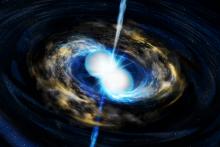The Astrophysical Journal
News
23 Mar 2023
Machine learning and state-of-the-art supernova nucleosynthesis has helped researchers find that the majority of observed second-generation stars in the universe were enriched by multiple supernovae.
27 Oct 2022
When two neutron stars merge, the resultant explosion forms heavy elements—many of which make up our Universe. A new study has, for the first time, identified the specific rare-earth elements produced in a neutron star merger.
18 Jan 2022
COW and GEP are new types of exploding stars. Researchers have succeeded in explaining the features of a new type of supernova which appears ten to a hundred times brighter at its peak, and with a much faster rise toward the peak compared to an ordinary supernova.
02 Dec 2020
A research team including Kavli IPMU Principal Investigator Naoki Yoshida has, in a world first, succeeded in performing a 6-dimensional simulation of neutrinos moving through the universe.
30 Mar 2020
Neon inside a certain star core can eat so many electrons, it causes the star to collapse into a neutron star and produce a supernova.
05 Feb 2020
The origin of how the Universe created its voids and filaments can now be studied within seconds after researchers developed an artificial intelligence tool called Dark Emulator.
Events
Sorry, no events coming up for this topic.
Researchers
Sorry, no researchers coming up for this topic.
Giants in history
Sorry, no researchers coming up for this topic.








